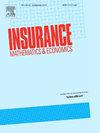为夫妻设计和评估新的股票挂钩保险产品
IF 2.2
2区 经济学
Q2 ECONOMICS
引用次数: 0
摘要
与股票挂钩的保险产品作为具有投资收益的退休产品,近年越来越受欢迎。然而,这些产品的设计和定价一直被忽视,尽管经验证据表明,积极的依赖在夫妇的一生。在本文中,我们提出了一些适合夫妇的产品,其中收益取决于双方生命的死亡时间,并在允许寿命依赖的情况下使用贴现密度法进行评估。通过使用二元混合Erlang分布对生命周期进行建模,为各种福利类型开发了封闭形式的定价公式,例如最后幸存者的收入保护(可能具有累积保证或福利指数化)和动态基金保护/提取。二元寿命数据的拟合也与二元拉盖尔级数有关。通过数值例子证明了依赖对这些产品价格的影响。特别是,我们的研究结果表明,与积极依赖的实际情况相比,错误地假设生命周期之间的独立性会使这些产品的价格过高,从而降低产品的吸引力。本文章由计算机程序翻译,如有差异,请以英文原文为准。
Designing and valuing new equity-linked insurance products for couples
Equity-linked insurance products have gained popularity in recent years as retirement products with investment benefits. However, the design and pricing of these products for couples have been overlooked despite empirical evidence showing positive dependence in a couple's lifetimes. In this paper, we propose some suitable products for couples where the benefits depend on the death times of both lives, and perform valuation using the discounted density approach while allowing the lifetimes to be dependent. By modeling the lifetimes with a bivariate mixed Erlang distribution, closed-form pricing formulas are developed for a variety of benefit types such as income protection for the last survivor (possibly with roll-up guarantee or benefit indexation) and dynamic fund protection/withdrawals. Fitting of bivariate lifetime data is also discussed in relation to bivariate Laguerre series. The impact of dependence on the prices of these products is demonstrated via numerical examples. In particular, our results suggest that incorrectly assuming independence between lifetimes would overprice these products compared to the actual situation of positive dependence, thereby making the products less attractive.
求助全文
通过发布文献求助,成功后即可免费获取论文全文。
去求助
来源期刊

Insurance Mathematics & Economics
管理科学-数学跨学科应用
CiteScore
3.40
自引率
15.80%
发文量
90
审稿时长
17.3 weeks
期刊介绍:
Insurance: Mathematics and Economics publishes leading research spanning all fields of actuarial science research. It appears six times per year and is the largest journal in actuarial science research around the world.
Insurance: Mathematics and Economics is an international academic journal that aims to strengthen the communication between individuals and groups who develop and apply research results in actuarial science. The journal feels a particular obligation to facilitate closer cooperation between those who conduct research in insurance mathematics and quantitative insurance economics, and practicing actuaries who are interested in the implementation of the results. To this purpose, Insurance: Mathematics and Economics publishes high-quality articles of broad international interest, concerned with either the theory of insurance mathematics and quantitative insurance economics or the inventive application of it, including empirical or experimental results. Articles that combine several of these aspects are particularly considered.
 求助内容:
求助内容: 应助结果提醒方式:
应助结果提醒方式:


